[4303] FSS Advanced Trailing StopStop Loss OrderType B PDF
1. Definition of Automatic Monitoring Order
Automatic monitoring order (automatic server stop loss) refers to a function or screen (program) that stores
monitoring conditions and order settings for stocks owned by the user or specific stocks, monitors them on the
Finansia HERO Monitoring System for a given period, and automatically places an order when monitoring conditions are
fulfilled.
[4303] FSS Advanced Trailing Stop / Stop Loss Order (Type B) Screen is a screen that can monitor and place an order (regardless of whether HTS is ON/OFF) without having to turn HTS ON. ‘Automatic monitoring order’ refers to a function that monitors conditions set by the user and automatically places an order on the Finansia HERO Monitoring System without additional confirmation, as long as monitoring conditions are met.
※ Precaution ※
The automatic monitoring order screen can monitor and place automatic orders even if the screen is closed because the Finansia HERO Monitoring System automatically performs price monitoring and order placement during the given period once monitoring is started. Be careful as price monitoring and order placement can be continued automatically for up to 30 days after turning HERO FSS off.
This screen has a convenient and useful function that can automatically handle orders by configuring market conditions as wanted by the user, but accurate understanding of the concept of automatic monitoring order, stop loss and trailing stop functions is necessary. We recommend using the screen after reading and understanding the precaution and manual.
[4303] FSS Advanced Trailing Stop / Stop Loss Order (Type B) Screen is a screen that can monitor and place an order (regardless of whether HTS is ON/OFF) without having to turn HTS ON. ‘Automatic monitoring order’ refers to a function that monitors conditions set by the user and automatically places an order on the Finansia HERO Monitoring System without additional confirmation, as long as monitoring conditions are met.
※ Precaution ※
The automatic monitoring order screen can monitor and place automatic orders even if the screen is closed because the Finansia HERO Monitoring System automatically performs price monitoring and order placement during the given period once monitoring is started. Be careful as price monitoring and order placement can be continued automatically for up to 30 days after turning HERO FSS off.
This screen has a convenient and useful function that can automatically handle orders by configuring market conditions as wanted by the user, but accurate understanding of the concept of automatic monitoring order, stop loss and trailing stop functions is necessary. We recommend using the screen after reading and understanding the precaution and manual.
2. Monitoring Time and Stocks Available for Monitoring
① Monitoring and order time for stocks owned and new stocks: Open 1 (10:00 ~ 12:30), open 2 (14:30~16:30)
② Monitoring time for portfolio transferred: Open 1 (10:00 ~ 12:30), open 2 (14:30~16:30)
③ Saving of monitoring conditions: Available 24 hours (except during system maintenance at 04:00 ~ 05:30)
④ Available stocks: SET, MAI
② Monitoring time for portfolio transferred: Open 1 (10:00 ~ 12:30), open 2 (14:30~16:30)
③ Saving of monitoring conditions: Available 24 hours (except during system maintenance at 04:00 ~ 05:30)
④ Available stocks: SET, MAI
3. Limitation on Monitoring Conditions
- Number of monitoring conditions: 20 conditions for automatic selling of stocks owned, 20 conditions for
automatic buying of new stocks, 5 conditions for automatic selling of portfolio transferred
- Effective period of monitoring conditions: 30 days (including Saturday, Sunday and holidays on the calendar)
- When the effective period of monitoring conditions expires, monitoring conditions will be stopped automatically after the expiration date.
※ Monitoring conditions for automatic selling of portfolio transferred can be saved for up to 30 days.
- Effective period of monitoring conditions: 30 days (including Saturday, Sunday and holidays on the calendar)
- When the effective period of monitoring conditions expires, monitoring conditions will be stopped automatically after the expiration date.
※ Monitoring conditions for automatic selling of portfolio transferred can be saved for up to 30 days.
4. Precautions for Automatic Monitoring Order
① After adding monitoring conditions, monitoring only begins by clicking ‘Start Monitoring’. Be aware that
monitoring does not begin simply after adding conditions.
② If monitoring is started after saving monitoring conditions, monitoring and order placement are performed by the monitoring system of our company, regardless of whether HTS is ON/OFF.
③ If an order is placed by fulfilling monitoring conditions, monitoring conditions are deleted. Monitoring order history must be confirmed in the automatic order history.
④ Deletion of monitoring history
If an order is placed by fulfilling monitoring conditions for automatic selling of stocks owned or automatic buying of new stocks after monitoring begins, monitoring conditions will be deleted from monitoring history. Therefore, monitoring history, automatic order history and trade completion should be checked frequently.
▶ Monitoring conditions are deleted if automatic order is placed by fulfilling monitoring conditions.
▶ All monitoring conditions of a stock are deleted if multiple monitoring conditions are set for the same s tock and remaining volume of the stock becomes ‘0’.
▶ Conditions can be deleted if an error occurs on the automatic monitoring system.
⑤ Suspension of monitoring
A. If the following stock information is received from stock exchange about a stock being monitored, monitoring for automatic selling of stocks owned and automatic buying of new stocks is forcibly suspended. This suspension will be notified via emergency SMS contact. (When stock right alteration information is received, monitoring is suspended at 17:30.)
▶ A stock for which a corporate action will occur on the following day is suspended on the day, and a push file is sent to the customer. Monitoring conditions for the stock cannot be entered until 7 AM on the following day.
▶ A stock for which a par value change will occur on the following day is suspended the day, and a push file is sent to the customer. Monitoring conditions for the stock cannot be entered until 7 AM on the following day.
▶ A stock for which a stock symbol change will occur on the following day is deleted on the day, and a push file is sent to the customer. Monitoring conditions for the stock cannot be entered until 7 AM on the following day.
▶ Settlement selling stocks
B. Our company may decide to forcibly suspend monitoring as below if a situation like system error occurs.
▶ Our company may suspend all monitoring conditions if it is deemed necessary due to error in the entire system, program and price or system back-up.
⑥ Automatic monitoring order settings are managed separately according to user ID, and they cannot be used concurrently on multiple devices (PC, mobile, etc.).
② If monitoring is started after saving monitoring conditions, monitoring and order placement are performed by the monitoring system of our company, regardless of whether HTS is ON/OFF.
③ If an order is placed by fulfilling monitoring conditions, monitoring conditions are deleted. Monitoring order history must be confirmed in the automatic order history.
④ Deletion of monitoring history
If an order is placed by fulfilling monitoring conditions for automatic selling of stocks owned or automatic buying of new stocks after monitoring begins, monitoring conditions will be deleted from monitoring history. Therefore, monitoring history, automatic order history and trade completion should be checked frequently.
▶ Monitoring conditions are deleted if automatic order is placed by fulfilling monitoring conditions.
▶ All monitoring conditions of a stock are deleted if multiple monitoring conditions are set for the same s tock and remaining volume of the stock becomes ‘0’.
▶ Conditions can be deleted if an error occurs on the automatic monitoring system.
⑤ Suspension of monitoring
A. If the following stock information is received from stock exchange about a stock being monitored, monitoring for automatic selling of stocks owned and automatic buying of new stocks is forcibly suspended. This suspension will be notified via emergency SMS contact. (When stock right alteration information is received, monitoring is suspended at 17:30.)
▶ A stock for which a corporate action will occur on the following day is suspended on the day, and a push file is sent to the customer. Monitoring conditions for the stock cannot be entered until 7 AM on the following day.
▶ A stock for which a par value change will occur on the following day is suspended the day, and a push file is sent to the customer. Monitoring conditions for the stock cannot be entered until 7 AM on the following day.
▶ A stock for which a stock symbol change will occur on the following day is deleted on the day, and a push file is sent to the customer. Monitoring conditions for the stock cannot be entered until 7 AM on the following day.
▶ Settlement selling stocks
B. Our company may decide to forcibly suspend monitoring as below if a situation like system error occurs.
▶ Our company may suspend all monitoring conditions if it is deemed necessary due to error in the entire system, program and price or system back-up.
⑥ Automatic monitoring order settings are managed separately according to user ID, and they cannot be used concurrently on multiple devices (PC, mobile, etc.).
5. Order Precautions
① If price suddenly changes due to unexpected market situation and massive orders occur that exceed system
capacity of our company, some orders can be omitted or delayed.
② When `automatic selling of stocks owned’ is configured, average buying price is set to buying price at the time of addition of conditions. Average buying price of real-time portfolio transferred later is not reflected on the price automatically. Therefore, reconfigure conditions if you would like to adjust buying price.
③ If price and quantity unit during order setting do not agree, order will be rejected when order price is outside the range of ceiling, floor and price limit. Monitoring conditions and history are deleted.
④ When conditions are fulfilled and an order is placed after monitoring starts, the order can be rejected due to lack of orderable quantity, balance and deposit. Make sure to check monitoring history and automatic order history.
⑤ After placement of automatic order by monitoring, balance from partial completion is not taken into account.
⑥ Monitoring conditions and monitoring history are deleted upon selling (settlement) of balance of stocks being monitored.
② When `automatic selling of stocks owned’ is configured, average buying price is set to buying price at the time of addition of conditions. Average buying price of real-time portfolio transferred later is not reflected on the price automatically. Therefore, reconfigure conditions if you would like to adjust buying price.
③ If price and quantity unit during order setting do not agree, order will be rejected when order price is outside the range of ceiling, floor and price limit. Monitoring conditions and history are deleted.
④ When conditions are fulfilled and an order is placed after monitoring starts, the order can be rejected due to lack of orderable quantity, balance and deposit. Make sure to check monitoring history and automatic order history.
⑤ After placement of automatic order by monitoring, balance from partial completion is not taken into account.
⑥ Monitoring conditions and monitoring history are deleted upon selling (settlement) of balance of stocks being monitored.
6. Monitoring Precautions
① Errors such as incomplete order can occur or order can be delayed by delay of transfer and omission of price
in case of sudden price fluctuation and flooding of orders. Also, order can be transacted at unwanted price.
② In case of sudden price fluctuation and flooding of orders, order may not be completed if incomplete order from take profit, profit preserve and cut loss is higher or lower than current price.
③ Since current price is updated according to order setting at the time of fulfillment of monitoring conditions, there may be a difference between current price and price that fulfills monitoring conditions in case of sudden price fluctuation.
④ After adding or modifying monitoring conditions, order can be placed as soon as monitoring begins if monitoring conditions are fulfilled because of sudden price fluctuation.
⑤ Monitoring starts at current price at the time of monitoring start if monitoring reference price is set to current price. When stopping and restarting monitoring, monitoring base price will be changed to current price at the starting time. Monitoring and order price conditions are automatically changed based on current price at the time.
⑥ When setting monitoring conditions for trailing stop, monitoring base price is based on current price. Start price and stop order price are set according to current price at the starting time. Since monitoring is done based on current price without calculating average buying price of stocks owned, order can be placed in the loss section depending on price situation.
⑦ In case of trailing stop monitoring, monitoring status upon closing of the market is maintained after reaching start price. Monitoring will be continued according to market price upon opening of the market on the following day.
⑧ If start price is not used in trailing stop monitoring, trailing monitoring begins when monitoring starts. Order can be placed by fulfilling conditions at price lower than monitoring base price.
⑨ Monitoring records for given conditions will be reset when trailing stop monitoring is restarted. Therefore, be careful as start price, high price, lower price and stop order price reached during monitoring before restart will be reset.
⑩ Even if monitoring conditions for automatic selling of balanced transfer is set under 90 days, effective period of monitoring conditions switched to automatic selling of stocks owned through portfolio transferred is automatically set to 90 days from the initial date of monitoring.
⑪ While monitoring automatic selling of portfolio transferred, if a specific stock is matched and switched to automatic selling of stocks owned, stop loss monitoring base price is based on average buying price of the initially matched portion (however, trailing stop monitoring base price is based on current price at the time of initial matching). Average buying price of real-time portfolio transferred later is not reflected automatically. Therefore, monitoring conditions must be reconfigured to reflect average buying price for balance additionally transferred after setting of conditions.
⑫ If matching data are received from the stock exchange upon opening of the market (including time before formation of market price) before market price data, order can be placed by fulfilling conditions based on closing price of the previous day (base price).
⑬ If balance is transferred from a stock that corresponds to calculation of market base price or change of base price such as settlement trading, change of face value, revaluation, ex-rights, new listing and relisting and is switched to automatic selling of stocks owned, unwanted order can be placed due to price difference at the opening of the market.
⑭ Automatic monitoring order may not be placed properly due to poor internet or communication environment of the user, error of the stock exchange or system error of our company. Therefore, it is necessary to check monitoring conditions, order placement and matching frequently.
⑮ Monitoring of various prices and conditions available on HERO FSS can be started at once. Automatic stock monitoring can be started and stopped using button, and monitoring status can be checked.
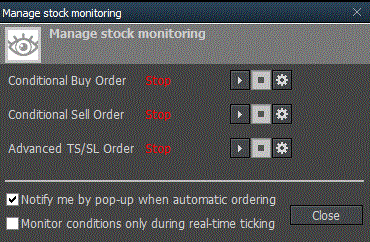
② In case of sudden price fluctuation and flooding of orders, order may not be completed if incomplete order from take profit, profit preserve and cut loss is higher or lower than current price.
③ Since current price is updated according to order setting at the time of fulfillment of monitoring conditions, there may be a difference between current price and price that fulfills monitoring conditions in case of sudden price fluctuation.
④ After adding or modifying monitoring conditions, order can be placed as soon as monitoring begins if monitoring conditions are fulfilled because of sudden price fluctuation.
⑤ Monitoring starts at current price at the time of monitoring start if monitoring reference price is set to current price. When stopping and restarting monitoring, monitoring base price will be changed to current price at the starting time. Monitoring and order price conditions are automatically changed based on current price at the time.
⑥ When setting monitoring conditions for trailing stop, monitoring base price is based on current price. Start price and stop order price are set according to current price at the starting time. Since monitoring is done based on current price without calculating average buying price of stocks owned, order can be placed in the loss section depending on price situation.
⑦ In case of trailing stop monitoring, monitoring status upon closing of the market is maintained after reaching start price. Monitoring will be continued according to market price upon opening of the market on the following day.
⑧ If start price is not used in trailing stop monitoring, trailing monitoring begins when monitoring starts. Order can be placed by fulfilling conditions at price lower than monitoring base price.
⑨ Monitoring records for given conditions will be reset when trailing stop monitoring is restarted. Therefore, be careful as start price, high price, lower price and stop order price reached during monitoring before restart will be reset.
⑩ Even if monitoring conditions for automatic selling of balanced transfer is set under 90 days, effective period of monitoring conditions switched to automatic selling of stocks owned through portfolio transferred is automatically set to 90 days from the initial date of monitoring.
⑪ While monitoring automatic selling of portfolio transferred, if a specific stock is matched and switched to automatic selling of stocks owned, stop loss monitoring base price is based on average buying price of the initially matched portion (however, trailing stop monitoring base price is based on current price at the time of initial matching). Average buying price of real-time portfolio transferred later is not reflected automatically. Therefore, monitoring conditions must be reconfigured to reflect average buying price for balance additionally transferred after setting of conditions.
⑫ If matching data are received from the stock exchange upon opening of the market (including time before formation of market price) before market price data, order can be placed by fulfilling conditions based on closing price of the previous day (base price).
⑬ If balance is transferred from a stock that corresponds to calculation of market base price or change of base price such as settlement trading, change of face value, revaluation, ex-rights, new listing and relisting and is switched to automatic selling of stocks owned, unwanted order can be placed due to price difference at the opening of the market.
⑭ Automatic monitoring order may not be placed properly due to poor internet or communication environment of the user, error of the stock exchange or system error of our company. Therefore, it is necessary to check monitoring conditions, order placement and matching frequently.
⑮ Monitoring of various prices and conditions available on HERO FSS can be started at once. Automatic stock monitoring can be started and stopped using button, and monitoring status can be checked.

7. Screen Composition for Automatic Selling of Stocks Owned
- Conditions of automatic monitoring and order can be applied to automatic selling of stocks owned and automatic
buying of new stocks under the tab at the top of the screen.
- To apply monitoring for automatic selling of stocks currently in the account, select “Automatic Selling of Stocks Owned” tab.
- To apply monitoring for automatic buying of stocks to be bought, select “Automatic Buying of New Stocks” tab.
- Click at the top right corner to check the
precaution for automatic stock monitoring and order.
at the top right corner to check the
precaution for automatic stock monitoring and order.
- Click button at the top right corner to view
monitoring conditions added in automatic selling of stocks owned and automatic buying of new stocks and to start
or stop monitoring.
button at the top right corner to view
monitoring conditions added in automatic selling of stocks owned and automatic buying of new stocks and to start
or stop monitoring.
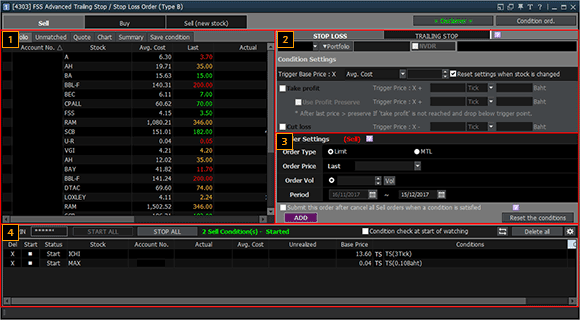
- To apply monitoring for automatic selling of stocks currently in the account, select “Automatic Selling of Stocks Owned” tab.
- To apply monitoring for automatic buying of stocks to be bought, select “Automatic Buying of New Stocks” tab.
- Click
- Click

View general stock information
Click each tab to check basic information about the stock for monitoring such as portfolio / unmatched / quote / chart / summary / user condition. The general information tabs include portfolio, unmatched, current price quote, monitoring chart, summary of monitoring conditions, and user condition saving screen where monitoring conditions can be viewed, saved and edited.
Click each tab to check basic information about the stock for monitoring such as portfolio / unmatched / quote / chart / summary / user condition. The general information tabs include portfolio, unmatched, current price quote, monitoring chart, summary of monitoring conditions, and user condition saving screen where monitoring conditions can be viewed, saved and edited.
Monitoring condition setting
Monitoring conditions are divided into two cases, ‘stop loss’ and ‘trailing stop’, and set differently.
‘Stop loss monitoring’ is a monitoring function that places an order when monitoring price set by the user is reached to take profit or cut loss.
‘Trailing stop monitoring’ is a monitoring function that pursues maximized profit or minimized loss by tracking price increase. When current price starts to fall after renewing a high, order is placed at preset monitoring price.
Take profit / profit preserve / cut loss / trailing stop conditions can be configured for stocks selected in the portfolio.
Monitoring conditions are divided into two cases, ‘stop loss’ and ‘trailing stop’, and set differently.
‘Stop loss monitoring’ is a monitoring function that places an order when monitoring price set by the user is reached to take profit or cut loss.
‘Trailing stop monitoring’ is a monitoring function that pursues maximized profit or minimized loss by tracking price increase. When current price starts to fall after renewing a high, order is placed at preset monitoring price.
Take profit / profit preserve / cut loss / trailing stop conditions can be configured for stocks selected in the portfolio.
Order settings
Order processing method to be applied to monitoring can be configured for stocks selected in the portfolio.
Order processing method to be applied to monitoring can be configured for stocks selected in the portfolio.
Monitoring history for automatic selling of stocks owned
Monitoring with conditions added can be viewed in monitoring history, and up to 10 stocks can be monitored concurrently. Monitoring conditions can be started, stopped or deleted individually or at the same time.
Monitoring with conditions added can be viewed in monitoring history, and up to 10 stocks can be monitored concurrently. Monitoring conditions can be started, stopped or deleted individually or at the same time.
8. Detailed Explanation of Screen for Automatic Selling of Stocks Owned
View general stock information
Click each tab to check basic information about the stock for monitoring such as portfolio / unmatched / quote / chart / summary / user condition. The general information tabs include portfolio, unmatched, current price quote, monitoring chart, summary of monitoring conditions, and user condition saving screen where monitoring conditions can be viewed, saved and edited
Click each tab to check basic information about the stock for monitoring such as portfolio / unmatched / quote / chart / summary / user condition. The general information tabs include portfolio, unmatched, current price quote, monitoring chart, summary of monitoring conditions, and user condition saving screen where monitoring conditions can be viewed, saved and edited
Portfolio
Information about all accounts linked to current ID can be checked at a sight.
Account status including account number, stock code, stock name, buy price, stocks on hand, orderable quantity, valuation profit or loss and rate of return can be checked in real time.
Click a stock owned from the portfolio list to set and change conditions. Stocks with V mark in the checkbox on the left can apply the same conditions at once.
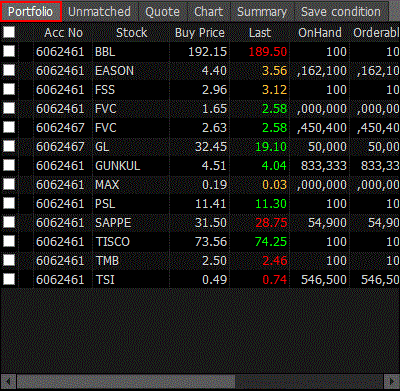
* Drag the scroll bar at the bottom to the right to view valuation profit or loss and rate of return fields.
Information about all accounts linked to current ID can be checked at a sight.
Account status including account number, stock code, stock name, buy price, stocks on hand, orderable quantity, valuation profit or loss and rate of return can be checked in real time.
Click a stock owned from the portfolio list to set and change conditions. Stocks with V mark in the checkbox on the left can apply the same conditions at once.

* Drag the scroll bar at the bottom to the right to view valuation profit or loss and rate of return fields.
Unmatched
Currently unmatched stocks can be viewed. Matching and unmatching of buy and sell orders placed during the
market are reflected in real time. Unmatched order quantity shown on this screen can be changed or cancelled all
at once.
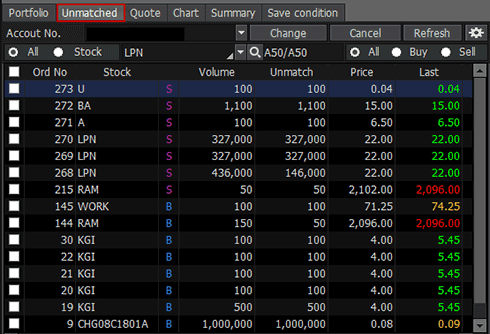
* Drag the scroll bar at the bottom to the right to view current price, status, order type, original order number and order time fields.
Click button to open the ‘stock unmatch setting’
pop-up window. Show cancel all order confirmation and show cancel button options can be set.
button to open the ‘stock unmatch setting’
pop-up window. Show cancel all order confirmation and show cancel button options can be set.
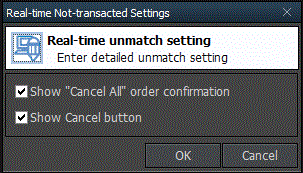

* Drag the scroll bar at the bottom to the right to view current price, status, order type, original order number and order time fields.
Click

Quote
This is a screen that shows the last price of selected stock.
 button is used to check chart and hourly
matching in the past 10 days. Pivot / demark analysis can be viewed in addition to daily price data.
button is used to check chart and hourly
matching in the past 10 days. Pivot / demark analysis can be viewed in addition to daily price data.
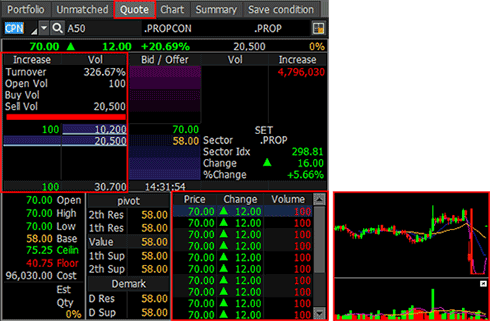
※ Click right mouse button on volume of each bid to use various screens and functions
This is a screen that shows the last price of selected stock.

※ Click right mouse button on volume of each bid to use various screens and functions
Monitoring Chart
Monitoring condition setting information of the stock selected from the monitoring list is shown as a chart. This is an intuitive way to understand monitoring situation according to price fluctuation. Monitoring conditions entered in monitoring condition setting are expressed as horizontal solid line along price on the Y axis, and arrival of current price at monitoring price can be confirmed immediately
Monitoring condition setting information of the stock selected from the monitoring list is shown as a chart. This is an intuitive way to understand monitoring situation according to price fluctuation. Monitoring conditions entered in monitoring condition setting are expressed as horizontal solid line along price on the Y axis, and arrival of current price at monitoring price can be confirmed immediately
Stop Loss (Take Profit, Profit Preserve, Cut Loss) Monitoring Chart
Color of the chart differs according to monitoring types such as base price, take profit, profit preserve and cut loss. Details of monitoring are illustrated in colors during ‘monitoring’, and virtual monitoring conditions are shown in gray color when monitoring is ‘stopped’.
※ However, if price is set to current price at the start of monitoring, monitoring conditions are not displayed on the chart screen when monitoring is ‘stopped’.
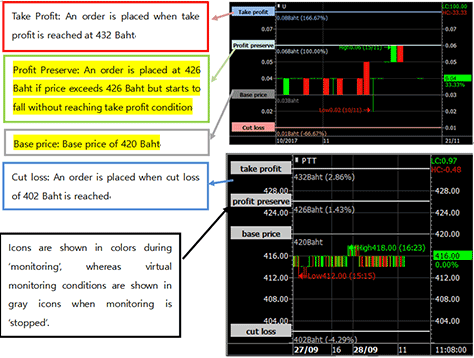
Color of the chart differs according to monitoring types such as base price, take profit, profit preserve and cut loss. Details of monitoring are illustrated in colors during ‘monitoring’, and virtual monitoring conditions are shown in gray color when monitoring is ‘stopped’.
※ However, if price is set to current price at the start of monitoring, monitoring conditions are not displayed on the chart screen when monitoring is ‘stopped’.

Trailing Stop Monitoring Chart
Different colors are used according to details of monitoring such as base price, start price, high price and
stop. Icons are shown in colors during ‘monitoring’, and monitoring conditions are not shown when monitoring is
‘stopped’.
If start price is set by selecting monitoring base price as current price at the start of monitoring, ‘High Price’ is turned into ‘Trail’ once high price (current price) reaches start price. ‘Stop’ icon monitoring falling of price is also changed to color. In other words, trailing stop monitoring begins when the black-and-white monitoring icon turns into color.
If start price is not set, trailing stop monitoring is run at the start of monitoring and all icons are immediately shown in colors.
However, if monitoring base price is selected as ‘average buying price’ or ‘direct input of base price’, ‘Trail’ icon is shown to imply the start of trailing monitoring. ‘Stop’ icon is displayed in color only if monitoring base price is exceeded, indicating that monitoring and order placement are only available in profit section.
In other words, if monitoring base price is selected as ‘average buying price’ or ‘direct input of base price’, trailing stop order is only placed at price higher than monitoring base price.
If high price (current price) continues to increase after exceeding start price, ‘Trail’ and ‘Stop’ icons are recalculated in real time according to renewal of high price.
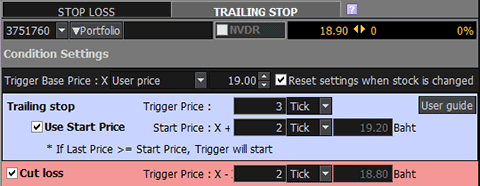
((Let’s see how the chart changes according to changing price while monitoring under the conditions above.)) This is a chart that first appears when start monitoring is clicked after adding conditions. User conditions are displayed.
If start price is set by selecting monitoring base price as current price at the start of monitoring, ‘High Price’ is turned into ‘Trail’ once high price (current price) reaches start price. ‘Stop’ icon monitoring falling of price is also changed to color. In other words, trailing stop monitoring begins when the black-and-white monitoring icon turns into color.
If start price is not set, trailing stop monitoring is run at the start of monitoring and all icons are immediately shown in colors.
However, if monitoring base price is selected as ‘average buying price’ or ‘direct input of base price’, ‘Trail’ icon is shown to imply the start of trailing monitoring. ‘Stop’ icon is displayed in color only if monitoring base price is exceeded, indicating that monitoring and order placement are only available in profit section.
In other words, if monitoring base price is selected as ‘average buying price’ or ‘direct input of base price’, trailing stop order is only placed at price higher than monitoring base price.
If high price (current price) continues to increase after exceeding start price, ‘Trail’ and ‘Stop’ icons are recalculated in real time according to renewal of high price.

((Let’s see how the chart changes according to changing price while monitoring under the conditions above.)) This is a chart that first appears when start monitoring is clicked after adding conditions. User conditions are displayed.
Summary
This is a screen that summarizes details of monitoring condition setting and order setting selected from the
monitoring list for easy understanding. Take profit, profit preserve and cut loss monitoring values configured
by the user for each monitoring condition unit (Tick/Baht/%) are converted into price (Baht) and displayed
according to bid unit.
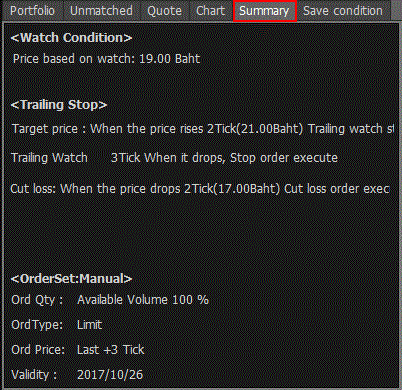

Save Condition
Monitoring conditions and order methods can be added and saved as user condition. Setting of order conditions
saved can be viewed, changed and deleted. Condition name can be changed.
1. Select the wanted stock under ‘Stop Loss for Stocks Owned’ tab or select ‘Stop Loss for Portfolio Transferred’ tab.
2. Monitoring condition setting moves along the choice of ‘Stop Loss’ or ‘Trailing Stop’ tab under monitoring condition setting.
3. Select an order condition saved in user conditions and ‘Add Condition’.
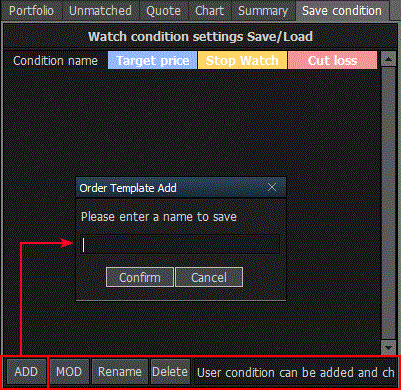
Select ‘Trailing Stop’ to load ‘start price / stop monitoring / loss limitation’ condition.
Select ‘Stop Loss’ to load ‘take profit / profit preserve / cut loss’ condition.
After setting the condition, click button on the
left side to enter name of the condition.
button on the
left side to enter name of the condition.
1. Select the wanted stock under ‘Stop Loss for Stocks Owned’ tab or select ‘Stop Loss for Portfolio Transferred’ tab.
2. Monitoring condition setting moves along the choice of ‘Stop Loss’ or ‘Trailing Stop’ tab under monitoring condition setting.
3. Select an order condition saved in user conditions and ‘Add Condition’.

Select ‘Trailing Stop’ to load ‘start price / stop monitoring / loss limitation’ condition.
Select ‘Stop Loss’ to load ‘take profit / profit preserve / cut loss’ condition.
After setting the condition, click
Monitoring condition setting for stocks owned
Stop loss monitoring (take profit, profit preserve and cut loss) and trailing stop monitoring conditions can be
set for a stock selected from the portfolio.
Different colors are used according to monitoring type and conditions. Monitoring conditions are explained easily to help intuitive understanding.
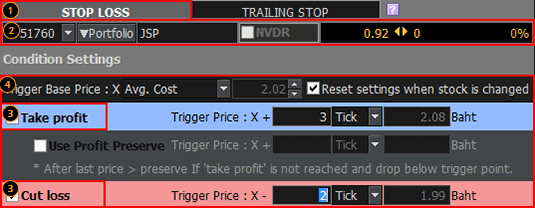
Different colors are used according to monitoring type and conditions. Monitoring conditions are explained easily to help intuitive understanding.

‘Stop loss monitoring’ is a monitoring function that places an order when monitoring price set
by the user is reached to take profit or cut loss.
Current price / change / change rate / volume of the stock selected from the portfolio can be
viewed.
Select a monitoring base price among ‘buying price / direct input of base price / current price
at the start of monitoring’.
If average buying price does not match bid unit, it is automatically corrected to higher bid based on bid unit.
“Reset monitoring conditions / order settings upon change of stock” is a setting to reset existing conditions upon changing of stock.
※ ‘Buying price’ is based on buying price upon initial ‘addition of conditions’. When the stock in the portfolio is additionally matched and transferred not during ‘monitoring’ after ‘addition of conditions’, buying price is not automatically recalculated.
Therefore, conditions need to be reconfigured to apply average buying price changed by the transferred portfolio to monitoring conditions.
If average buying price does not match bid unit, it is automatically corrected to higher bid based on bid unit.
“Reset monitoring conditions / order settings upon change of stock” is a setting to reset existing conditions upon changing of stock.
| Item | Description |
| Average buying price | Average buying price of the stock owned in the selected account |
| Direct input of base price | Price entered by the user |
| Last price at the start of monitoring | Last price when start monitoring ▶ button is clicked after adding conditions (If monitoring is stopped and restarted, price is reset to last price at the time of restart whenever ▶ button is clicked.) |
※ ‘Buying price’ is based on buying price upon initial ‘addition of conditions’. When the stock in the portfolio is additionally matched and transferred not during ‘monitoring’ after ‘addition of conditions’, buying price is not automatically recalculated.
Therefore, conditions need to be reconfigured to apply average buying price changed by the transferred portfolio to monitoring conditions.
One or more take profit / profit preserve / cut loss conditions can be selected. Select the checkbox to enable
each monitoring condition input field. Different color is used to show the selected condition according to
monitoring type.
However, ‘profit preserve’ setting cannot be done separately as it follows conditions for take profit.
Select and enter a unit among ‘Tick/Baht/%’ based on ‘monitoring base price’.
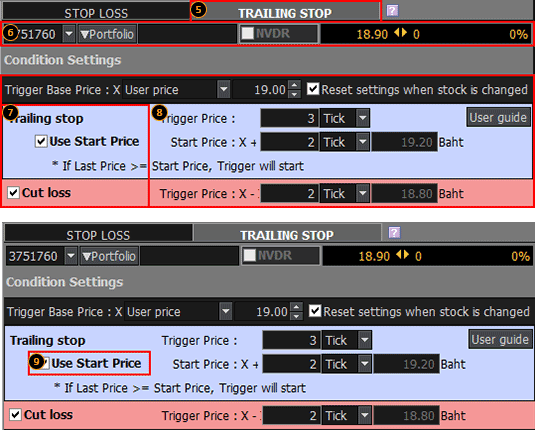
However, ‘profit preserve’ setting cannot be done separately as it follows conditions for take profit.
Select and enter a unit among ‘Tick/Baht/%’ based on ‘monitoring base price’.

‘Trailing stop monitoring’ is a monitoring function that pursues maximized profit or minimized
loss by tracking price increase. When current price starts to fall after renewing a high, order is placed at
preset monitoring price.
Current price / change / change rate / volume of the stock selected from the portfolio can be
viewed.
In default, monitoring base price is based on ‘current price at the start of monitoring’.
If monitoring base price is based on ‘current price at the start of monitoring’, monitoring and order placement can occur at price lower than average buying price of the portfolio and may result in loss.
If monitoring base price is set to ‘average buying price’ or ‘direct input of base price’, trailing stop monitoring only places an order at price higher than monitoring base price. However, if base price is entered to be lower than average buying price via ‘direct input of base price’, monitoring and order placement can be based on monitoring base price and may result in loss.
If monitoring base price is based on ‘current price at the start of monitoring’, monitoring and order placement can occur at price lower than average buying price of the portfolio and may result in loss.
If monitoring base price is set to ‘average buying price’ or ‘direct input of base price’, trailing stop monitoring only places an order at price higher than monitoring base price. However, if base price is entered to be lower than average buying price via ‘direct input of base price’, monitoring and order placement can be based on monitoring base price and may result in loss.
One or more of ‘start price / price drop during trailing monitoring / cut loss’ conditions can
be selected.
If ‘start price’ is used, trailing monitoring is started when price exceeds start price during monitoring.
‘Price drop during trailing monitoring’ condition can be used alone without using ‘start price’. In this case,
trailing monitoring will be started at the start of monitoring
※ Precautions for changing monitoring conditions during trailing stop monitoring
- If start price and monitoring base price are changed in the monitoring condition setting, high price is renewed based on current price. Start price can only be changed to price higher than high price if trailing has already begun.
- If start price is changed to price higher than high price in the monitoring condition setting, ‘Trailing’ is changed back to ‘High Price’ according to current price.
- Trailing stop monitoring continuously recalculates high price according to increase of current price.
If start price is used, ‘3 Tick’ is automatically set as default value. The user can enter desired start price to be 1 Tick or higher.
The monitoring condition is enabled by selecting the checkbox. Different color is used according to monitoring type.
※ Precautions for changing monitoring conditions during trailing stop monitoring
- If start price and monitoring base price are changed in the monitoring condition setting, high price is renewed based on current price. Start price can only be changed to price higher than high price if trailing has already begun.
- If start price is changed to price higher than high price in the monitoring condition setting, ‘Trailing’ is changed back to ‘High Price’ according to current price.
- Trailing stop monitoring continuously recalculates high price according to increase of current price.
If start price is used, ‘3 Tick’ is automatically set as default value. The user can enter desired start price to be 1 Tick or higher.
The monitoring condition is enabled by selecting the checkbox. Different color is used according to monitoring type.
If start price is used, ‘3 Tick’ is automatically set as default value. The user can enter desired start price
to be 1 Tick or higher.
The monitoring condition is enabled by selecting the checkbox. Different color is used according to monitoring type.
※ If monitoring base price is set to ‘current price at the start of monitoring’ and ‘price drop during trailing monitoring’ condition is used alone without using start price, ‘current price at the start of monitoring’ when start monitoring button is clicked becomes ‘high price’.
If ‘drop compared to highest price’ is set to 1 Tick and bid drops by 1 Tick immediately after monitoring begins, order can be placed immediately since 1 Tick has dropped from high price.
The monitoring condition is enabled by selecting the checkbox. Different color is used according to monitoring type.
| Item | Description |
| Use start price | Enter start price, indicating desired minimum price increase based on monitoring base price |
| Price drop during trailing monitoring | Enter allowable monitoring price drop compared to high price before stopping |
| Cut loss | Enter monitoring price based on allowable loss based on monitoring base price |
※ If monitoring base price is set to ‘current price at the start of monitoring’ and ‘price drop during trailing monitoring’ condition is used alone without using start price, ‘current price at the start of monitoring’ when start monitoring button is clicked becomes ‘high price’.
If ‘drop compared to highest price’ is set to 1 Tick and bid drops by 1 Tick immediately after monitoring begins, order can be placed immediately since 1 Tick has dropped from high price.
Order settings
The method of handling orders applied to monitoring of the stock selected from the portfolio can be set. Order conditions are preset to place an order when monitoring conditions are fulfilled during monitoring.
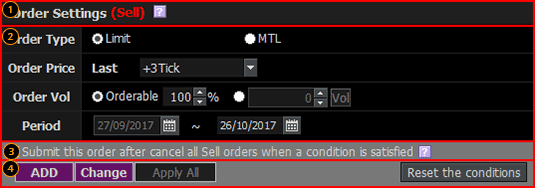
If there is a stock that fulfills monitoring conditions, order conditions for the stock can be selected between
manual order / automatic order.
In case of manual order, the order confirmation window appears when monitoring conditions are met, and the user is required to click ‘OK’ button to place the order. In case of automatic order, the order is placed immediately when monitoring conditions are met.
※ [4303] Automatic stock monitoring and order screen does not offer manual order function. Even if HTS is turned OFF, the Finansia HERO Monitoring System will monitor and place automatic order during the period.
In case of manual order, the order confirmation window appears when monitoring conditions are met, and the user is required to click ‘OK’ button to place the order. In case of automatic order, the order is placed immediately when monitoring conditions are met.
※ [4303] Automatic stock monitoring and order screen does not offer manual order function. Even if HTS is turned OFF, the Finansia HERO Monitoring System will monitor and place automatic order during the period.
Detailed order conditions such as order volume / order type / order price for the stock can be
entered.
Order Type: Limit or MTL
Order Price: Order price can be set as ‘+/- Tick’ based on current price.
Order Volume: Order volume can be entered as a ratio to orderable volume (%) or directly
entered by the user. ‘Calculate volume by amount’ can be selected to calculate volume based on the amount
entered.
Period: Period can be set up to 90 days from the date of condition setting. Monitoring will be
continued during this period.
※ Comparison of last price with price upon fulfillment of conditions
* Last price: Last price at the time of order placement after fulfillment of monitoring conditions is used as order price.
* Price upon fulfillment of conditions: Current price at the time of fulfillment of monitoring conditions is used as order price.
* Conditions can be fulfilled at price set by the user. If this price is an empty bid, price that fulfills the condition can be used instead of price set by the user.
※ Comparison of last price with price upon fulfillment of conditions
* Last price: Last price at the time of order placement after fulfillment of monitoring conditions is used as order price.
* Price upon fulfillment of conditions: Current price at the time of fulfillment of monitoring conditions is used as order price.
* Conditions can be fulfilled at price set by the user. If this price is an empty bid, price that fulfills the condition can be used instead of price set by the user.
‘Submit this order after cancelling all sell orders when a condition is satisfied’ is a
function that automatically cancels all unmatched sell orders before placing a new order so as to ensure that
the order is not rejected for ‘insufficient sellable volume’ due to existing unmatched orders.
Pin number must be saved before using this function on the screen
Pin number must be saved before using this function on the screen
The monitoring and order settings can be saved / changed.
Add condition: After entering the monitoring and order settings, click  button to add the monitoring conditions to the
stock.
button to add the monitoring conditions to the
stock.
Change condition: Select an existing condition, change the monitoring and order settings, and
then click  to apply changes.
to apply changes.
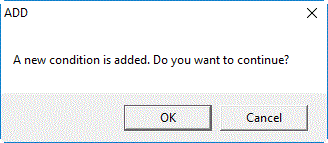

Apply to all conditions: To apply the conditions to multiple stocks at once, check (V) the
stocks wanted from the portfolio tab and click  button.
button.
Reset: Click this button to reset monitoring condition and sell order settings entered or
changed.
When apply all is used, the following confirmation pop-up screen appears. Select ‘Delete and Add’ button to delete all existing conditions and newly add stocks with check (V) mark. Select ‘Add’ button to add new conditions while maintaining existing conditions.

When apply all is used, the following confirmation pop-up screen appears. Select ‘Delete and Add’ button to delete all existing conditions and newly add stocks with check (V) mark. Select ‘Add’ button to add new conditions while maintaining existing conditions.

Monitoring history for automatic selling of stocks owned
Added monitoring conditions are displayed on the monitoring list. Stocks can be selected from the list to start / stop monitoring of individual or all stocks. Monitoring conditions and order settings applied to the stocks can be checked at a sight

Added monitoring conditions are displayed on the monitoring list. Stocks can be selected from the list to start / stop monitoring of individual or all stocks. Monitoring conditions and order settings applied to the stocks can be checked at a sight

All conditions on the monitoring list can be started / stopped / deleted using  ,
, ,
,  buttons. ‘Stopped condition monitoring’ or
‘Monitoring 1 stop loss condition for each stock’ message is displayed depending on monitoring status.
buttons. ‘Stopped condition monitoring’ or
‘Monitoring 1 stop loss condition for each stock’ message is displayed depending on monitoring status.
Individual conditions on the monitoring list can be started / stopped / deleted using  buttons, and current monitoring status can be checked.
buttons, and current monitoring status can be checked.
‘Stopped condition monitoring’ or ‘Monitoring 1 automatic order condition for stock owned’
message is displayed depending on monitoring status.
Click button to open ‘Field Setting’’ pop-up window.
The user can select monitoring fields to add / delete them.
button to open ‘Field Setting’’ pop-up window.
The user can select monitoring fields to add / delete them.
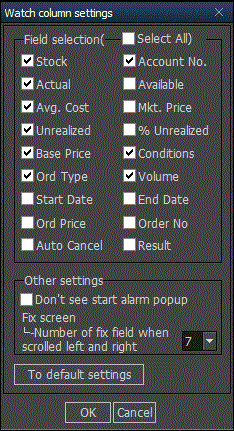
Click

9. Example of Monitoring for Automatic Selling of Stocks Owned
Select a stock owned from the portfolio tab to display the selected stock on the monitoring condition setting
window as shown in the example below.
Example 1) Setting of monitoring condition for stop loss take profit / cut loss
Assuming that we want to use stop loss monitoring. Set monitoring base price as average buying price of the stock owned.
Average buying price of the stock owned is 20.40 Baht.
Set monitoring price after selecting the take profit checkbox. If 20 Tick is entered into price increase compared to monitoring base price, 22.40 Baht is configured as take profit monitoring price.
Select the cut loss checkbox and set monitoring price. If 15 Tick is entered into price drop compared to monitoring base price, 18.90 Baht is configured as cut loss monitoring price.
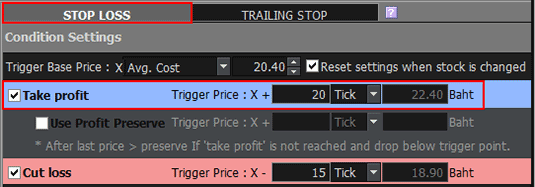 (Description of photograph – method of stop loss take profit monitoring)
(Description of photograph – method of stop loss take profit monitoring)
Stop loss take profit monitoring places an order when current price reaches preset monitoring price. Take profit order is placed when price reaches take profit monitoring price (22.40 Baht) while fluctuating.
Take profit price, monitoring base price, cut loss price, price increase, placement of take profit order, price increase
Assuming that we want to use stop loss monitoring. Set monitoring base price as average buying price of the stock owned.
Average buying price of the stock owned is 20.40 Baht.
Set monitoring price after selecting the take profit checkbox. If 20 Tick is entered into price increase compared to monitoring base price, 22.40 Baht is configured as take profit monitoring price.
Select the cut loss checkbox and set monitoring price. If 15 Tick is entered into price drop compared to monitoring base price, 18.90 Baht is configured as cut loss monitoring price.
 (Description of photograph – method of stop loss take profit monitoring)
(Description of photograph – method of stop loss take profit monitoring) Stop loss take profit monitoring places an order when current price reaches preset monitoring price. Take profit order is placed when price reaches take profit monitoring price (22.40 Baht) while fluctuating.

Take profit price, monitoring base price, cut loss price, price increase, placement of take profit order, price increase
Example 2) Setting of monitoring condition for stop loss profit preserve
Stop loss can monitor profit preserve in addition to take profit and cut loss.
However, profit preserve monitoring condition uses the same condition as take profit and cannot be set separately.
Select the take profit checkbox and set monitoring price. If 20 Tick is entered into price increase compared to monitoring base price, 22.40 Baht is configured as take profit monitoring price.
Select the profit preserve checkbox and set monitoring price. If 15 Tick is entered into price increase compared to monitoring base price, 21.90 Baht is configured as profit preserve monitoring price.
※ All monitoring conditions are set based on monitoring base price. For example, if unit of profit preserve condition is 10%, profit preserve = monitoring base price + (monitoring base price * 10%).
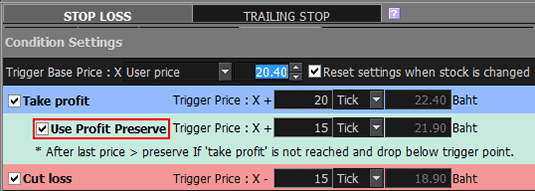 (Description of photograph – method of stop loss profit preserve monitoring)
(Description of photograph – method of stop loss profit preserve monitoring)
If current price reaches take profit monitoring price, take profit order is placed. If current price drops and reaches profit preserve monitoring price without reaching take profit monitoring price, profit preserve order is placed.
If price exceeds profit preserve monitoring price (21.90 Baht) and continues to increase but fails to reach take profit price before starting to drop, profit preserve order is placed when price reaches profit preserve monitoring price (21.90 Baht) again
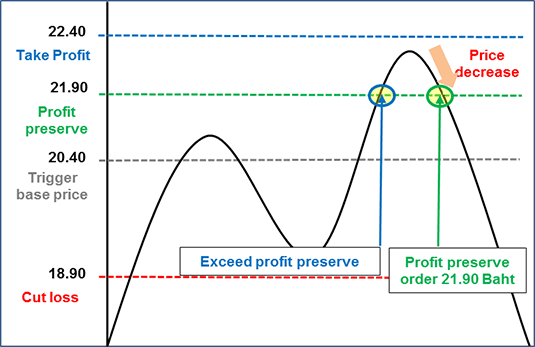
Take profit price, profit preserve price, monitoring base price, cut loss price, reaching of profit preserve monitoring price, placement of profit preserve order, price decrease
Stop loss can monitor profit preserve in addition to take profit and cut loss.
However, profit preserve monitoring condition uses the same condition as take profit and cannot be set separately.
Select the take profit checkbox and set monitoring price. If 20 Tick is entered into price increase compared to monitoring base price, 22.40 Baht is configured as take profit monitoring price.
Select the profit preserve checkbox and set monitoring price. If 15 Tick is entered into price increase compared to monitoring base price, 21.90 Baht is configured as profit preserve monitoring price.
※ All monitoring conditions are set based on monitoring base price. For example, if unit of profit preserve condition is 10%, profit preserve = monitoring base price + (monitoring base price * 10%).
 (Description of photograph – method of stop loss profit preserve monitoring)
(Description of photograph – method of stop loss profit preserve monitoring)If current price reaches take profit monitoring price, take profit order is placed. If current price drops and reaches profit preserve monitoring price without reaching take profit monitoring price, profit preserve order is placed.
If price exceeds profit preserve monitoring price (21.90 Baht) and continues to increase but fails to reach take profit price before starting to drop, profit preserve order is placed when price reaches profit preserve monitoring price (21.90 Baht) again

Take profit price, profit preserve price, monitoring base price, cut loss price, reaching of profit preserve monitoring price, placement of profit preserve order, price decrease
Example 3) Setting of monitoring condition for high price trailing stop
Monitoring conditions for trailing stop monitoring must be configured separately under trailing stop tab, which is separated from stop loss.
Time of trailing monitoring differs according to the use of start price. If monitoring is started without using start price, ‘high price trailing stop’ monitoring is done. Trailing monitoring will be started at monitoring base price (current price at the start of monitoring) of 19.10 Baht.
If 10 Tick is entered into trailing stop price, stop order price is set to be 10 ticks lower than high price.
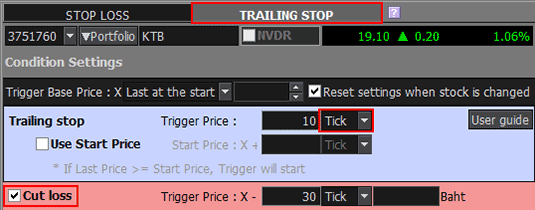 (Description of photograph – method of high price trailing stop monitoring)
(Description of photograph – method of high price trailing stop monitoring)
‘High price trailing stop’ starts trailing stop monitoring at the start of monitoring, and current price at the start of monitoring (19.10 Baht) becomes initial high price. High price is renewed according to price. Trailing stop order is placed when price drops by 10 ticks from latest high price.

Base price, Renewal of current high price, TS monitoring started at the start of monitoring, 2nd renewal of current high price, Dropped by 8 ticks and increased again, Dropped by 10 ticks, Placement of trailing stop order
Monitoring conditions for trailing stop monitoring must be configured separately under trailing stop tab, which is separated from stop loss.
Time of trailing monitoring differs according to the use of start price. If monitoring is started without using start price, ‘high price trailing stop’ monitoring is done. Trailing monitoring will be started at monitoring base price (current price at the start of monitoring) of 19.10 Baht.
If 10 Tick is entered into trailing stop price, stop order price is set to be 10 ticks lower than high price.
 (Description of photograph – method of high price trailing stop monitoring)
(Description of photograph – method of high price trailing stop monitoring)‘High price trailing stop’ starts trailing stop monitoring at the start of monitoring, and current price at the start of monitoring (19.10 Baht) becomes initial high price. High price is renewed according to price. Trailing stop order is placed when price drops by 10 ticks from latest high price.

Base price, Renewal of current high price, TS monitoring started at the start of monitoring, 2nd renewal of current high price, Dropped by 8 ticks and increased again, Dropped by 10 ticks, Placement of trailing stop order
Example 4) Setting of monitoring condition for start price trailing stop
Time of trailing monitoring differs according to the use of start price. If ‘Use Start Price’ is checked and 20 Tick is entered, trailing monitoring starts if price increases by 20 ticks or more after monitoring starts.
If 10 Tick is entered into trailing stop price, stop order price is set to be 10 ticks lower than high price.
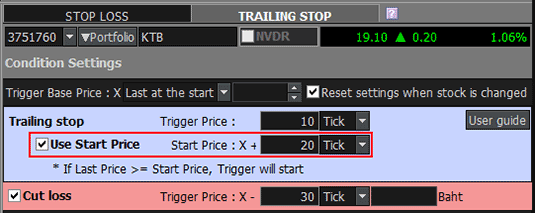 (Description of photograph – method of start price trailing stop monitoring)
(Description of photograph – method of start price trailing stop monitoring)
‘Start price trailing stop’ monitoring starts if current price increases and exceeds by 20 ticks or more (21.10 Baht) compared to start price.
High price is renewed (22.10 Baht) according to price. Trailing stop order is placed when price drops by 10 ticks (21.10 Baht) from latest high price.
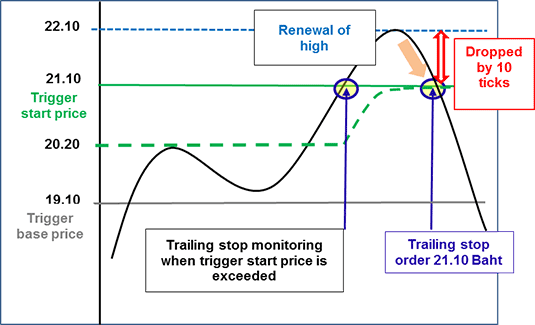
Base price, TS monitoring when TS start price is exceeded, Renewal of current high price, Dropped by 10 ticks, Placement of trailing stop order
Time of trailing monitoring differs according to the use of start price. If ‘Use Start Price’ is checked and 20 Tick is entered, trailing monitoring starts if price increases by 20 ticks or more after monitoring starts.
If 10 Tick is entered into trailing stop price, stop order price is set to be 10 ticks lower than high price.
 (Description of photograph – method of start price trailing stop monitoring)
(Description of photograph – method of start price trailing stop monitoring)‘Start price trailing stop’ monitoring starts if current price increases and exceeds by 20 ticks or more (21.10 Baht) compared to start price.
High price is renewed (22.10 Baht) according to price. Trailing stop order is placed when price drops by 10 ticks (21.10 Baht) from latest high price.

Base price, TS monitoring when TS start price is exceeded, Renewal of current high price, Dropped by 10 ticks, Placement of trailing stop order
10. Screen Composition for Automatic Buying of New Stocks
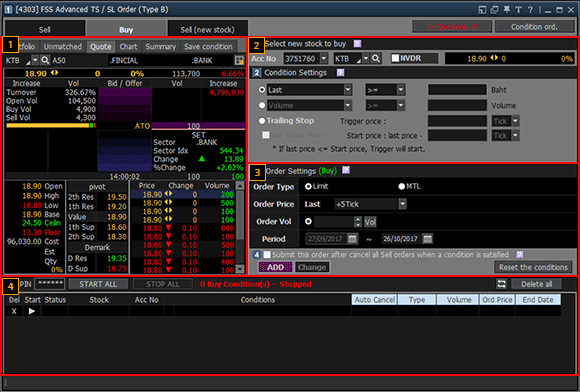
View general stock information
Click each tab to check basic information about the stock for monitoring such as portfolio / unmatched / quote / chart / summary / user condition. The general information tabs include portfolio, unmatched, current price quote, monitoring chart, summary of monitoring conditions, and user condition saving screen where monitoring conditions can be viewed, saved and edited
Click each tab to check basic information about the stock for monitoring such as portfolio / unmatched / quote / chart / summary / user condition. The general information tabs include portfolio, unmatched, current price quote, monitoring chart, summary of monitoring conditions, and user condition saving screen where monitoring conditions can be viewed, saved and edited
Monitoring condition setting
- Monitoring conditions are divided into two cases, ‘specific price condition’ and ‘low price trailing stop’, and set differently.
- Monitoring condition at the top is a function that places an order when monitoring conditions set by the user such as current price, market price, high price, low price, change compared to previous day, change rate, volume and completion volume are fulfilled.
- ‘Low price trailing stop order’ is a function to buy stocks at advantageous conditions by tracking price. Order is placed at preset low price monitoring price when current price renews low price and starts to increase.
- When buying a specific stock, order can be set to ‘specific price condition’ or ‘low price trailing stop’.
- Monitoring conditions are divided into two cases, ‘specific price condition’ and ‘low price trailing stop’, and set differently.
- Monitoring condition at the top is a function that places an order when monitoring conditions set by the user such as current price, market price, high price, low price, change compared to previous day, change rate, volume and completion volume are fulfilled.
- ‘Low price trailing stop order’ is a function to buy stocks at advantageous conditions by tracking price. Order is placed at preset low price monitoring price when current price renews low price and starts to increase.
- When buying a specific stock, order can be set to ‘specific price condition’ or ‘low price trailing stop’.
Order settings
Order processing method to be applied to monitoring can be configured for stocks selected.
Order processing method to be applied to monitoring can be configured for stocks selected.
Monitoring history for portfolio transferred stop loss
Monitoring with conditions added can be viewed in monitoring history, and up to 20 stocks can be monitored concurrently. Monitoring conditions can be started, stopped or deleted individually or at the same time.
Monitoring with conditions added can be viewed in monitoring history, and up to 20 stocks can be monitored concurrently. Monitoring conditions can be started, stopped or deleted individually or at the same time.
11. Detailed Explanation of Screen for Automatic Buying of New Stocks
View general stock information
Click each tab to check basic information about the stock for monitoring such as portfolio / unmatched / quote / chart / summary / user condition. The general information tabs include portfolio, unmatched, current price quote, monitoring chart, summary of monitoring conditions, and user condition saving screen where monitoring conditions can be viewed, saved and edited.
- The general stock information area is a common screen for automatic selling of stocks owned tab and automatic buying of new stocks tab. Please refer to the section on the screen for automatic selling of stocks owned.
Click each tab to check basic information about the stock for monitoring such as portfolio / unmatched / quote / chart / summary / user condition. The general information tabs include portfolio, unmatched, current price quote, monitoring chart, summary of monitoring conditions, and user condition saving screen where monitoring conditions can be viewed, saved and edited.
- The general stock information area is a common screen for automatic selling of stocks owned tab and automatic buying of new stocks tab. Please refer to the section on the screen for automatic selling of stocks owned.
Monitoring condition setting
Order can be set to ‘specific price condition’ or ‘low price trailing stop’ when buying a specific stock.
Different colors are used according to monitoring type and conditions. Monitoring conditions are explained easily to help intuitive understanding.
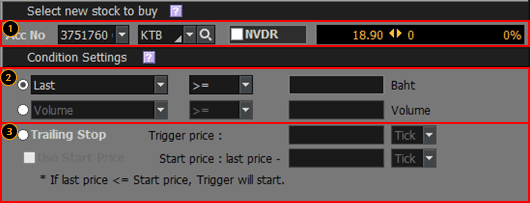
Order can be set to ‘specific price condition’ or ‘low price trailing stop’ when buying a specific stock.
Different colors are used according to monitoring type and conditions. Monitoring conditions are explained easily to help intuitive understanding.

‘Automatic buying of new stocks’ is a monitoring function that places a buying order when
‘specific condition’ is fulfilled for a specific stock preset by the user. This is an area that displays the
stock to be set.
Monitoring places an order when conditions preset by the user such as “current price, market
price, high price, low price, change compared to previous day, change rate, volume, completion volume” (item)
are fulfilled.
Volume is cumulative (on the day) and completion volume is momentary volume of transactions completed.
Order is placed when the selected ‘item’ is greater than or equal to (>=) / less than or equal to (<=) the ‘condition value’ entered.
Volume is cumulative (on the day) and completion volume is momentary volume of transactions completed.
Order is placed when the selected ‘item’ is greater than or equal to (>=) / less than or equal to (<=) the ‘condition value’ entered.
‘Low price trailing stop order’ is a function to buy stocks at advantageous conditions by tracking price. Order
is placed at preset low price monitoring price when current price renews low price and starts to increase.
If Use Start Price is checked, the start price setting area is enabled as shown below.

Unit of condition value can be Tick/Baht/%. Trailing monitoring is activated when price of the stock selected fulfills monitoring conditions.
Trailing monitoring begins immediately upon starting of monitoring for automatic buying of new stocks without using start price.
If Use Start Price is checked, the start price setting area is enabled as shown below.

Unit of condition value can be Tick/Baht/%. Trailing monitoring is activated when price of the stock selected fulfills monitoring conditions.
Trailing monitoring begins immediately upon starting of monitoring for automatic buying of new stocks without using start price.
It is an option to initialize monitoring condition area and order setting area when changing stock.
Order settings
The method of handling orders applied to monitoring of the stock selected from the portfolio can be set. Order conditions are preset to place an order when monitoring conditions are fulfilled during monitoring
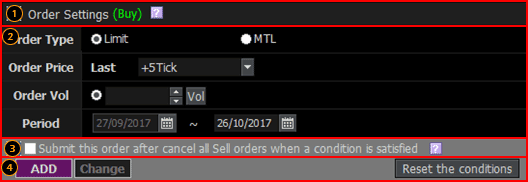
The method of handling orders applied to monitoring of the stock selected from the portfolio can be set. Order conditions are preset to place an order when monitoring conditions are fulfilled during monitoring

If there is a stock that fulfills monitoring conditions, the stock is ordered automatically.
Detailed order conditions such as order type / order price / order volume / period for the stock
can be entered.
Order Type: Limit or MTL
Order Price: Order price can be set as ‘+/- Tick’ based on current price.
Order Volume: Order volume can be entered as a ratio to orderable volume (%) or directly entered
by the user. ‘Calculate volume by amount’ can be selected to calculate volume based on the amount entered.
Period: Period can be set up to 90 days from the date of condition setting. Monitoring will be
continued during this period.
※ Comparison of current price with price upon fulfillment of conditions
Current price: Current price at the time of order placement after fulfillment of monitoring conditions is used as order price.
Price upon fulfillment of conditions: Current price at the time of fulfillment of monitoring conditions is used as order price.
Conditions can be fulfilled at price set by the user. If this price is an empty offer, price that fulfills the condition can be used instead of price set by the user.

※ Comparison of current price with price upon fulfillment of conditions
Current price: Current price at the time of order placement after fulfillment of monitoring conditions is used as order price.
Price upon fulfillment of conditions: Current price at the time of fulfillment of monitoring conditions is used as order price.
Conditions can be fulfilled at price set by the user. If this price is an empty offer, price that fulfills the condition can be used instead of price set by the user.

Submit this order after cancelling all buy orders when a condition is satisfied’ is a function
that automatically cancels all unmatched buy orders before placing a new order so as to ensure that the order is
not rejected for ‘insufficient buyable volume’ due to existing unmatched orders.
The monitoring and order settings can be saved / changed
Add condition: After entering the monitoring and order settings, click  button to add the monitoring conditions to the
stock.
button to add the monitoring conditions to the
stock.
Change condition: Select an existing condition, change the monitoring and order settings, and
then click  to apply changes.
to apply changes.
Monitoring history for automatic buying of new stocks
Added monitoring conditions are displayed on the monitoring list. Stocks can be selected from the list to start / stop monitoring of individual or all stocks. Monitoring conditions and order settings applied to all stocks or specific stocks to be transferred into portfolio through new buying can be checked at a sight

Added monitoring conditions are displayed on the monitoring list. Stocks can be selected from the list to start / stop monitoring of individual or all stocks. Monitoring conditions and order settings applied to all stocks or specific stocks to be transferred into portfolio through new buying can be checked at a sight

All conditions on the monitoring list can be started / stopped / deleted using  ,
, ,
,  buttons. ‘Stopped condition monitoring’ or
‘Monitoring 1 stop loss condition for each stock’ message is displayed depending on monitoring status.
buttons. ‘Stopped condition monitoring’ or
‘Monitoring 1 stop loss condition for each stock’ message is displayed depending on monitoring status.
Individual conditions on the monitoring list can be started / stopped / deleted using  buttons, and current monitoring status can be checked.
buttons, and current monitoring status can be checked.
12. Example of Low Price Trailing Stop Monitoring for Automatic Buying of New Stocks
Example 1) Setting of monitoring condition for low price trailing stop
Trailing stop monitoring needs to set monitoring conditions separately in the trailing stop area. Monitoring base price is fixed to ‘current price at the start of monitoring’.
Time of trailing stop monitoring differs according to the use of start price. If monitoring is started without using start price, ‘low price trailing stop’ monitoring is done. Trailing monitoring will be started at monitoring base price (current price at the start of monitoring).
If 10 Tick is entered into trailing stop price, stop order price is set to be 10 ticks higher than low price.

Description of photograph – method of low price trailing stop monitoring
‘Low price trailing stop’ starts trailing stop monitoring at the start of monitoring, and current price at the start of monitoring (20.00 Baht) becomes initial low price. Low price is renewed according to price. Trailing stop order is placed when price increases by 10 ticks (17.00 Baht) from latest low price (16.00 Baht).
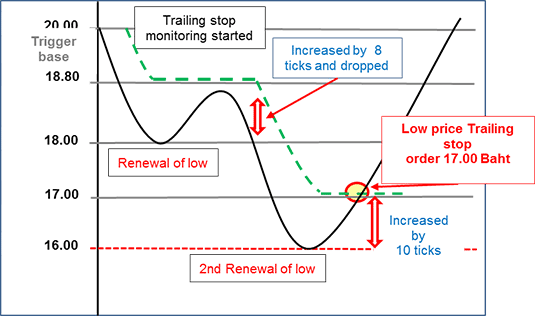
Trailing stop monitoring needs to set monitoring conditions separately in the trailing stop area. Monitoring base price is fixed to ‘current price at the start of monitoring’.
Time of trailing stop monitoring differs according to the use of start price. If monitoring is started without using start price, ‘low price trailing stop’ monitoring is done. Trailing monitoring will be started at monitoring base price (current price at the start of monitoring).
If 10 Tick is entered into trailing stop price, stop order price is set to be 10 ticks higher than low price.

Description of photograph – method of low price trailing stop monitoring
‘Low price trailing stop’ starts trailing stop monitoring at the start of monitoring, and current price at the start of monitoring (20.00 Baht) becomes initial low price. Low price is renewed according to price. Trailing stop order is placed when price increases by 10 ticks (17.00 Baht) from latest low price (16.00 Baht).

Example 2) Setting of monitoring condition for start price low price trailing stop
Time of trailing monitoring differs according to the use of start price. If ‘Use Start Price’ is checked and 10 Tick is entered, trailing monitoring starts if price drops by 10 ticks or more after monitoring starts.
If 20 Tick is entered into trailing stop price, stop order price is set to be 20 ticks higher than low price.

Description of photograph – method of start price low price trailing stop monitoring
Description of photograph – method of start price low price trailing stop monitoring
Low price is renewed (16.00 Baht) according to price. Trailing stop order is placed when price increases by 20 ticks (18.00 Baht) from latest low price.
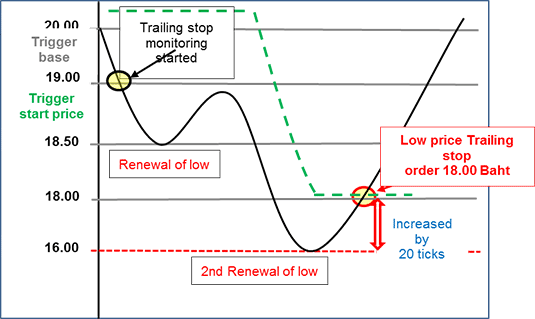
Base price, TS start price, TS monitoring when start price is exceeded, Renewal of current low price, 2nd renewal of current low price, Increased by 20 ticks, Placement of low price trailing stop buying order
Time of trailing monitoring differs according to the use of start price. If ‘Use Start Price’ is checked and 10 Tick is entered, trailing monitoring starts if price drops by 10 ticks or more after monitoring starts.
If 20 Tick is entered into trailing stop price, stop order price is set to be 20 ticks higher than low price.

Description of photograph – method of start price low price trailing stop monitoring
Description of photograph – method of start price low price trailing stop monitoring
Low price is renewed (16.00 Baht) according to price. Trailing stop order is placed when price increases by 20 ticks (18.00 Baht) from latest low price.

Base price, TS start price, TS monitoring when start price is exceeded, Renewal of current low price, 2nd renewal of current low price, Increased by 20 ticks, Placement of low price trailing stop buying order
13. Automatic Calculation of Bid or Offer Unit
The stop loss screen provides accurate monitoring price by automatically calculating price based on the unit of
monitoring condition set by the user among Tick, Baht and %.
If price of monitoring condition set by the user does not agree with unit of bid or offer, it is automatically compensated by the setting window. Refer to the examples below for the method of calculating monitoring price.
If price of monitoring condition set by the user does not agree with unit of bid or offer, it is automatically compensated by the setting window. Refer to the examples below for the method of calculating monitoring price.
Example 1) Stop loss monitoring base price: 18.40 Baht
Unit of bid or offer for price between 10 Baht ~ 25 Baht is 0.10 Baht.
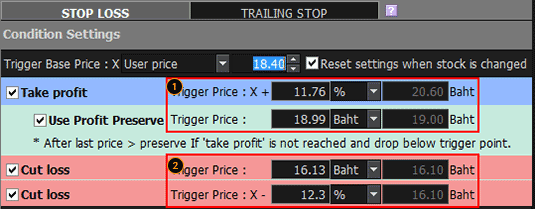
Unit of bid or offer for price between 10 Baht ~ 25 Baht is 0.10 Baht.

Bid or offer is rounded up for monitoring price in the profit section.
- ‘%’ unit: Price calculated by adding 11.76% to base price is rounded up according to unit of bid or offer.
Monitoring price: Monitoring base price + 11.76% (2.16384) = 20.56384 Baht > rounded up => 20.60 Baht
- ‘Baht’ unit: Input price is rounded up according to unit of bid or offer.
Monitoring price: 18.99 Baht > rounded up => 19.00 Baht
- ‘%’ unit: Price calculated by adding 11.76% to base price is rounded up according to unit of bid or offer.
Monitoring price: Monitoring base price + 11.76% (2.16384) = 20.56384 Baht > rounded up => 20.60 Baht
- ‘Baht’ unit: Input price is rounded up according to unit of bid or offer.
Monitoring price: 18.99 Baht > rounded up => 19.00 Baht
Bid or offer is rounded down for monitoring price in the loss section
- ‘%’ unit: Price calculated by subtracting 12.30% from base price is rounded down according to unit of bid or offer.
Monitoring price: Monitoring base price - 12.30% (2.2632) = 16.1368 Baht > rounded down => 16.10 Baht
- ‘Baht’ unit: Input price is rounded down according to unit of bid or offer.
Monitoring price: 16.13 Baht > rounded down => 16.10 Baht
- ‘%’ unit: Price calculated by subtracting 12.30% from base price is rounded down according to unit of bid or offer.
Monitoring price: Monitoring base price - 12.30% (2.2632) = 16.1368 Baht > rounded down => 16.10 Baht
- ‘Baht’ unit: Input price is rounded down according to unit of bid or offer.
Monitoring price: 16.13 Baht > rounded down => 16.10 Baht
Example 2) Stop loss monitoring base price: Direct input of base
price: 18.41 Baht
Unit of bid or offer for price between 10 Baht ~ 25 Baht is 0.10 Baht.
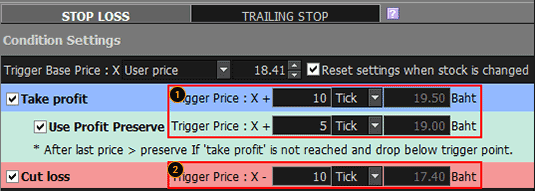
If monitoring base price entered by the user does not agree with unit of bid or offer, monitoring base price is automatically compensated according to unit of bid or offer on the monitoring condition setting window.
Unit of bid or offer for price between 10 Baht ~ 25 Baht is 0.10 Baht.

If monitoring base price entered by the user does not agree with unit of bid or offer, monitoring base price is automatically compensated according to unit of bid or offer on the monitoring condition setting window.
Bid or offer is rounded up for monitoring price in the profit section.
- Price calculated by adding 10 ticks to base price is rounded up according to unit of bid or offer.
Monitoring price: Monitoring base price + 10 ticks = 19.41 Baht > rounded up => 19.50 Baht
Monitoring price: Monitoring base price + 5 ticks = 18.91 Baht > rounded up => 19.00 Baht
- Price calculated by adding 10 ticks to base price is rounded up according to unit of bid or offer.
Monitoring price: Monitoring base price + 10 ticks = 19.41 Baht > rounded up => 19.50 Baht
Monitoring price: Monitoring base price + 5 ticks = 18.91 Baht > rounded up => 19.00 Baht
Bid or offer is rounded down for monitoring price in the loss section.
- Price calculated by subtracting 10 ticks from base price is rounded down according to unit of bid or offer.
Monitoring price: Monitoring base price – 10 ticks = 17.41 Baht > rounded down => 17.40 Baht
- Price calculated by subtracting 10 ticks from base price is rounded down according to unit of bid or offer.
Monitoring price: Monitoring base price – 10 ticks = 17.41 Baht > rounded down => 17.40 Baht
Example 3) Trailing stop monitoring base price: Current price at
the start of monitoring
Unit of bid or offer for price between 10 Baht ~ 25 Baht is 0.10 Baht.
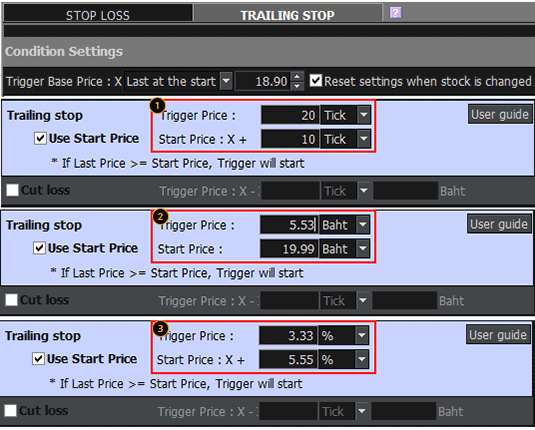
If monitoring base price entered by the user does not agree with unit of bid or offer, monitoring base price is automatically compensated according to unit of bid or offer on the monitoring condition setting window.
Unit of bid or offer for price between 10 Baht ~ 25 Baht is 0.10 Baht.

If monitoring base price entered by the user does not agree with unit of bid or offer, monitoring base price is automatically compensated according to unit of bid or offer on the monitoring condition setting window.
In case of ‘Tick’ unit, the number of ticks is added to current price to calculate start price.
- Start price: Current price + 10 ticks (1.0 Baht) = 19.90 Baht
In case of ‘Tick’ unit, the Trigger price is high price minus the number of ticks.
- Trigger Price : High: 22.80 – 20 ticks (2.00 Baht) = 20.80 Baht
- Start price: Current price + 10 ticks (1.0 Baht) = 19.90 Baht
In case of ‘Tick’ unit, the Trigger price is high price minus the number of ticks.
- Trigger Price : High: 22.80 – 20 ticks (2.00 Baht) = 20.80 Baht
In case of ‘Baht’ unit, input start price is rounded up according to unit of bid or offer.
- Start price: 19.99 Baht > rounded up >= 20.00 Baht
In case of ‘Baht’ unit, input trigger price is rounded down according to unit of bid or offer.
- Trigger price: High price of 24.80 - 5.53 Baht = 19.27 > rounded down >= 19.20 Baht
- Start price: 19.99 Baht > rounded up >= 20.00 Baht
In case of ‘Baht’ unit, input trigger price is rounded down according to unit of bid or offer.
- Trigger price: High price of 24.80 - 5.53 Baht = 19.27 > rounded down >= 19.20 Baht
In case of ‘%’ unit, start price is calculated by adding 5.55% to current price and rounding up according to
unit of bid or offer.
- Start price: Current price + 5.55 % (1.04895) = 19.94895 Baht > rounded up => 20.00 Baht
In case of ‘%’ unit, trigger price is calculated by subtracting 3.33% from high price and rounding down according to unit of bid or offer.
- Trigger price: High price of 22.80 Baht - 3.33% (0.62937) = 19.52937 Baht > rounded down => 19.50 Baht
※ When high price is renewed, stop price is recalculated based on highest price and is reflected on the chart in real time.
If monitoring base price is set to current price at the start of monitoring, monitoring and order placement can be done at price lower than average buying price of the portfolio and may result in loss.
In addition, be careful as order can be placed immediately after monitoring starts if price suddenly changes and reaches monitoring price.
- Start price: Current price + 5.55 % (1.04895) = 19.94895 Baht > rounded up => 20.00 Baht
In case of ‘%’ unit, trigger price is calculated by subtracting 3.33% from high price and rounding down according to unit of bid or offer.
- Trigger price: High price of 22.80 Baht - 3.33% (0.62937) = 19.52937 Baht > rounded down => 19.50 Baht
※ When high price is renewed, stop price is recalculated based on highest price and is reflected on the chart in real time.
If monitoring base price is set to current price at the start of monitoring, monitoring and order placement can be done at price lower than average buying price of the portfolio and may result in loss.
In addition, be careful as order can be placed immediately after monitoring starts if price suddenly changes and reaches monitoring price.
14. Screen Composition for Automatic Selling of Portfolio Transferred

View general stock information
Click each tab to check basic information about the stock for monitoring such as portfolio / unmatched / quote / chart / summary / user condition. The general information tabs include portfolio, unmatched, current price quote, monitoring chart, summary of monitoring conditions, and user condition saving screen where monitoring conditions can be viewed, saved and edited.
Click each tab to check basic information about the stock for monitoring such as portfolio / unmatched / quote / chart / summary / user condition. The general information tabs include portfolio, unmatched, current price quote, monitoring chart, summary of monitoring conditions, and user condition saving screen where monitoring conditions can be viewed, saved and edited.
Monitoring condition setting
- Monitoring conditions are divided into two cases, ‘stop loss’ and ‘trailing stop’, and set differently.
- ‘Stop loss monitoring’ is a monitoring function that places an order when monitoring price set by the user is reached to take profit or cut loss.
‘Trailing stop monitoring’ is a monitoring function that pursues maximized profit or minimized loss by tracking price increase. When current price starts to fall after renewing a high, order is placed at preset monitoring price.
- Monitoring conditions are divided into two cases, ‘stop loss’ and ‘trailing stop’, and set differently.
- ‘Stop loss monitoring’ is a monitoring function that places an order when monitoring price set by the user is reached to take profit or cut loss.
‘Trailing stop monitoring’ is a monitoring function that pursues maximized profit or minimized loss by tracking price increase. When current price starts to fall after renewing a high, order is placed at preset monitoring price.
Order settings (Sell)
Order processing method to be applied to monitoring can be configured for stocks selected.
Order processing method to be applied to monitoring can be configured for stocks selected.
Monitoring history for automatic selling of portfolio transferred
Monitoring with conditions added can be viewed in monitoring history, and up to 5 stocks can be monitored concurrently. Monitoring conditions can be started, stopped or deleted individually or at the same time.
Monitoring with conditions added can be viewed in monitoring history, and up to 5 stocks can be monitored concurrently. Monitoring conditions can be started, stopped or deleted individually or at the same time.
15. Detailed Explanation of Screen
View general stock information
Click each tab to check basic information about the stock for monitoring such as portfolio / unmatched / quote /
chart / summary / user condition. The general information tabs include portfolio, unmatched, current price
quote, monitoring chart, summary of monitoring conditions, and user condition saving screen where monitoring
conditions can be viewed, saved and edited.
Monitoring condition setting
Take profit, profit preserve, cut loss and trailing stop conditions can be set for stocks being transferred to
the account portfolio through new buying. Different colors are used according to monitoring type and conditions.
Monitoring conditions are explained easily to help intuitive understanding
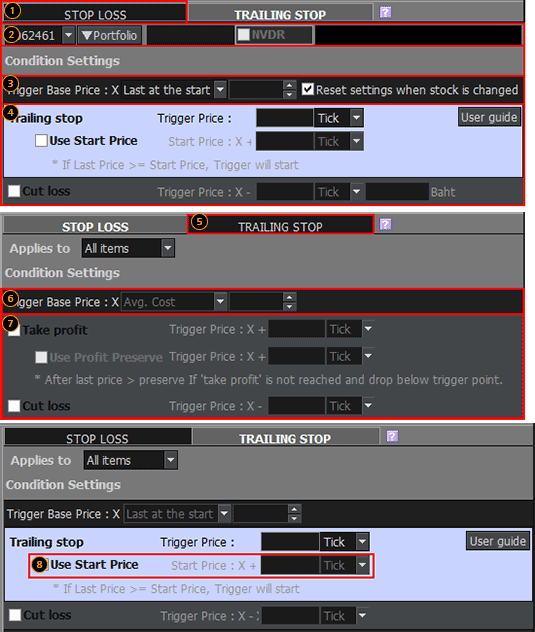

Stop loss monitoring’ is a monitoring function that places an order when monitoring price set by
the user is reached to take profit or cut loss. Stop loss monitoring is started based on preset monitoring
conditions upon transfer of account portfolio.
Monitoring conditions can be applied only to stocks that satisfy specific conditions such as all
stocks / price range / stock type / account number among stocks to be transferred to account portfolio
| Item | Description |
| All | stocks Conditions applied to all stocks to be transferred to portfolio |
| Price | range Conditions only applied to stocks that satisfy the preset price range upon transfer to portfolio |
| Stock | type Selection of market type of the stock between 'SET / MAI' |
| Account | number Conditions only applied to one of the accounts connected to current ID |
Monitoring base price in the ‘stop loss’ setting for automatic selling of portfolio transferred
can only use `buying price`.
One or more take profit / profit preserve / cut loss conditions can be selected. Select the
checkbox to enable each monitoring condition input field. Different color is used to show the selected condition
according to monitoring type.
However, ‘profit preserve’ setting cannot be done separately as it follows conditions for take profit.
Select and enter a unit among ‘Tick/Baht/%’ based on ‘monitoring base price’.
However, ‘profit preserve’ setting cannot be done separately as it follows conditions for take profit.
Select and enter a unit among ‘Tick/Baht/%’ based on ‘monitoring base price’.
‘Trailing stop monitoring’ is a monitoring function that pursues maximized profit or minimized
loss by tracking price increase. When current price starts to fall after renewing a high, order is placed at
preset monitoring price.
Monitoring base price of ‘trailing stop’ for portfolio transferred is fixed to ‘current price
at the start of monitoring’.
Since trailing stop monitoring starts at the same time as portfolio transferred, monitoring base price is set to current price at the start of monitoring. Monitoring base price can be changed after portfolio transferred by changing the setting under automatic selling of stocks owned tab.
Since trailing stop monitoring starts at the same time as portfolio transferred, monitoring base price is set to current price at the start of monitoring. Monitoring base price can be changed after portfolio transferred by changing the setting under automatic selling of stocks owned tab.
One or more of ‘start price / price drop during trailing monitoring / cut loss’ conditions can
be selected.
If ‘start price’ is used, trailing monitoring is started when price exceeds start price during monitoring. ‘Price drop during trailing monitoring’ condition can be used alone without using ‘start price’. In this case, trailing monitoring will be started at the start of monitoring.
If ‘start price’ is used, trailing monitoring is started when price exceeds start price during monitoring. ‘Price drop during trailing monitoring’ condition can be used alone without using ‘start price’. In this case, trailing monitoring will be started at the start of monitoring.
If start price is used, ‘3 Tick’ is automatically set as default value. The user can enter
desired start price to be 1 Tick or higher. The monitoring condition is enabled by selecting the checkbox.
Different color is used according to monitoring type.
※ If ‘price drop during trailing monitoring’ condition is used alone without using start price, ‘current price at the start of monitoring’ when start monitoring button is clicked becomes ‘high price’.
If ‘drop compared to highest price’ is set to 1 Tick and bid drops by 1 Tick immediately after monitoring begins, order can be placed immediately since 1 Tick has dropped from high price.
| Item | Description |
| Use start price | Enter start price, indicating desired minimum price increase based on monitoring base price |
| Price drop during trailing monitoring | Enter allowable monitoring price drop compared to high price before stopping (if high price is renewed, stop price is automatically recalculated) |
| Cut loss | Enter monitoring price based on allowable loss based on monitoring base price |
Order settings
The method of handling orders applied to monitoring of the stock selected from the portfolio can be set. Order conditions are preset to place an order when monitoring conditions are fulfilled during monitoring.
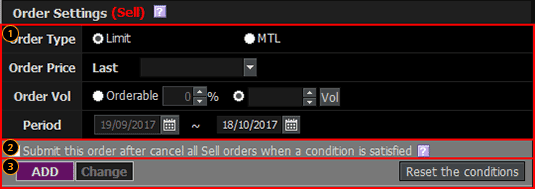
The method of handling orders applied to monitoring of the stock selected from the portfolio can be set. Order conditions are preset to place an order when monitoring conditions are fulfilled during monitoring.

Detailed order conditions such as order type / order price / order volume / period can be entered for the stock
by adding automatic selling of portfolio transferred.
Order Type: Limit or MTL
Order Price: Order price can be set as ‘+/- Tick’ based on current price.
Order Volume: Order volume can be entered as a ratio to orderable volume (%) or directly entered
by the user. ‘Calculate by amount’ can be selected to calculate volume based on the amount entered.
Period: Period of monitoring for automatic selling of portfolio transferred can be set.
* Even if period of monitoring for automatic selling of portfolio transferred is set under 90 days, period of monitoring of stocks owned switched to automatic selling of portfolio transferred is automatically set to 30 days from the initial date of monitoring. For example, if monitoring conditions for portfolio transferred are set and 100 FSS stocks are transferred to the portfolio on August 21, FSS monitoring for automatic selling will continue until September 20 (30 days after the date of portfolio transfer).
* Even if period of monitoring for automatic selling of portfolio transferred is set under 90 days, period of monitoring of stocks owned switched to automatic selling of portfolio transferred is automatically set to 30 days from the initial date of monitoring. For example, if monitoring conditions for portfolio transferred are set and 100 FSS stocks are transferred to the portfolio on August 21, FSS monitoring for automatic selling will continue until September 20 (30 days after the date of portfolio transfer).
Submit this order after cancelling all sell orders when a condition is satisfied’ is a function that
automatically cancels all unmatched sell orders before placing a new order so as to ensure that the order is not
rejected for ‘insufficient sellable volume’ due to existing unmatched orders.
The monitoring and order settings can be saved / changed.
Monitoring history for automatic selling of portfolio transferred

Added monitoring conditions are displayed on the monitoring list. Stocks can be selected from the list to start / stop monitoring of individual or all stocks. Monitoring conditions and order settings applied to all stocks or specific stocks to be transferred to the portfolio through new buying can be checked at a sight.

Added monitoring conditions are displayed on the monitoring list. Stocks can be selected from the list to start / stop monitoring of individual or all stocks. Monitoring conditions and order settings applied to all stocks or specific stocks to be transferred to the portfolio through new buying can be checked at a sight.
All conditions on the monitoring list can be started / stopped / deleted using  ,
,  ,
,  buttons. ‘Stopped monitoring 0 condition for
automatic selling of portfolio transferred’ or ‘Monitoring x conditions for automatic selling of portfolio
transferred’ message is displayed depending on monitoring status.
buttons. ‘Stopped monitoring 0 condition for
automatic selling of portfolio transferred’ or ‘Monitoring x conditions for automatic selling of portfolio
transferred’ message is displayed depending on monitoring status.
Individual conditions on the monitoring list can be started / stopped / deleted using buttons,
and current monitoring status can be checked.
16. Precautions for Automatic Selling of Portfolio Transferred
Automatic selling of portfolio transferred: Automatic selling of portfolio transferred refers to
a function that saves monitoring conditions for a stock that is not currently in the account to apply the
conditions automatically as ‘automatic selling of stocks owned’ after it is bought and transferred to the
portfolio.
Automatic selling of portfolio transferred uses the same screen as automatic selling of stocks
owned (general setting). Please refer to explanation on the screen for automatic selling of stocks owned.
Monitoring for automatic selling of portfolio transferred starts upon initial completion of unowned stock, and order is placed with volume in the portfolio at the time if conditions are fulfilled immediately after monitoring starts. Therefore, if an order is placed by fulfilling the conditions immediately after monitoring starts with initially matched volume, partially matched volume other than initially matched volume is not included in selling and settlement order volume.
(However, this is only applied if order is set to 100% of sellable and settlement volume. This does not apply to cases in which accurate selling volume is directly entered.)
In case of simultaneous bids and offers at the closing and opening of the market, receiving of price and transaction completion data from the stock exchange can be delayed by flooding volume of orders completed. Please keep this in mind, especially when prices are fluctuating and transaction completion data are flooding.
(However, this is only applied if order is set to 100% of sellable and settlement volume. This does not apply to cases in which accurate selling volume is directly entered.)
In case of simultaneous bids and offers at the closing and opening of the market, receiving of price and transaction completion data from the stock exchange can be delayed by flooding volume of orders completed. Please keep this in mind, especially when prices are fluctuating and transaction completion data are flooding.
※ Characteristics of automatic selling of stocks owned and automatic selling of portfolio transferred ※
Automatic selling of stocks owned can set stop loss and trailing stop monitoring conditions for the existing portfolio in the account. Automatic selling of portfolio transferred saves monitoring conditions for a stock that does not exist in the account and applies the conditions to the new stock bought and transferred to the portfolio automatically switching to ‘automatic selling of stocks owned’.
In other words, monitoring conditions are only applied to the existing portfolio, both for automatic selling of stocks owned and automatic selling of portfolio transferred.
In addition, whereas different conditions can be set for different stocks in case of automatic selling of stocks owned, automatic selling of portfolio transferred can only set conditions before the target stocks are bought. Therefore, even if multiple stocks are newly bought, single condition set previously will be applied to all stocks.
Thus, conditions cannot be set differently for different stocks to be transferred to the portfolio. Single condition set by the user will apply to all stocks being transferred to the portfolio.
Automatic selling of stocks owned can set stop loss and trailing stop monitoring conditions for the existing portfolio in the account. Automatic selling of portfolio transferred saves monitoring conditions for a stock that does not exist in the account and applies the conditions to the new stock bought and transferred to the portfolio automatically switching to ‘automatic selling of stocks owned’.
In other words, monitoring conditions are only applied to the existing portfolio, both for automatic selling of stocks owned and automatic selling of portfolio transferred.
In addition, whereas different conditions can be set for different stocks in case of automatic selling of stocks owned, automatic selling of portfolio transferred can only set conditions before the target stocks are bought. Therefore, even if multiple stocks are newly bought, single condition set previously will be applied to all stocks.
Thus, conditions cannot be set differently for different stocks to be transferred to the portfolio. Single condition set by the user will apply to all stocks being transferred to the portfolio.
